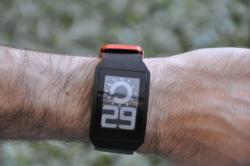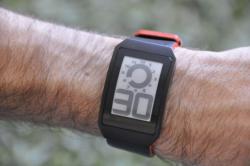A few months ago Art Technology released a new range of E Ink watches, called Phosphor watches. Now they have released a new model (black case Digital Hour), and have kindly send us one for review. The watch is now available for 190$.
The watch
The Digital Hour watch is a curved, light-weight watch. It's not thin, though, which is surprising because the display itself is very thin (more on this later, but it's under 400 micron thick!). The watch functions are pretty basic: you can view the time (in two modes: analog/digital combined, and just digital), the date, and there's also an alarm you can setup. The watch is always in 12-hours mode (no military time).
There are two buttons: one is used to flip between the 4 display modes (analog/digital time, digital time, date and alarm setup). The other button is used to flip the display between white on black or black on white. The two buttons are also used to setup the watch. You can see the analog/digital mode above, and here are the other 3 modes (from left to right: digital time, date and alarm). You can tell it's the date mode because of the small icon on the top-left.






